Low Back Pain Exercises At Home
Lower back pain is an incredibly common condition that can be relieved or prevented with regular exercise and stretching.
Contents
What is Low Back Pain?
“Most back pain is mechanical, meaning day-to-day life stresses lead to overload,” says Ted Dreisinger, PhD, a trustee of McKenzie Institute International, an advocacy group for people with musculoskeletal conditions and associate editor of The Spine Journal.
Most low back pain is as a result of an injury, such as muscle sprains or strains due to sudden movements or poor body mechanics while lifting heavy objects
Symptoms Of Lower Back Pain
- Lower back pain symptoms can come on suddenly or appear gradually.
- Sometimes, pain occurs after a specific event, such as bending to pick something up.
- Other times, you may not know what caused the pain.
- Pain may be sharp or dull and achy, and it may radiate to your bottom or down the back of your legs (sciatica).
- If you strain your back during an activity, you may hear a “pop” when it happened.
- Pain is often worse in certain positions (like bending over) and gets better when you lie down.
Other symptoms of lower back pain include:
- Stiffness:It may be tough to move or straighten your back. Getting up from a seated position may take a while, and you might feel like you need to walk or stretch to loosen up. You may notice decreased range of motion.
- Posture problems: Many people with back pain find it hard to stand up straight. Your lower back may look flat instead of curved.
- Muscle spasms: After a strain, muscles in the lower back can spasm or contract uncontrollably which can cause extreme pain and make it difficult or impossible to stand, walk or move.
Diagnosing Low Back Pain
Description of your back pain is very important for your doctor to diagnose your condition properly. It can be helpful to note when and where the back pain began, what activities you do, related symptoms, and any chronic medical conditions.
Tests Used to Diagnose Back Pain
- X-ray-Spine X-ray, which uses radiation to produce images of bones.
- Computerized tomography (CT)-CT scan, which uses X-rays and a computer to create 3D images of bones and soft tissues.
- Myelograms-Electromyography (EMG) to test nerves and muscles and check for neuropathy (nerve damage), which can cause tingling or numbness in your legs.
- Discography
- Magnetic resonance imaging (MRI)-MRI, which uses a magnet and radio waves to create pictures of bones, muscles, tendons and other soft tissues.
- Electrodiagnostics
- Bone scans
- Ultrasound imaging
- Blood tests-Blood tests can detect genetic markers for some conditions that cause back pain (such as ankylosing spondylitis)
- Urine tests check for kidney stones, which cause pain in the flank (the sides of the low back).
Causes Of Lower Back Pain
Lower Back Pain might be a symptom of an underlying condition, like kidney stones or acute pancreatitis. Other times, it’s simply a side effect of a sedentary lifestyle or repetitive motions.
- Strains and sprains: Back strains and sprains are the most common cause of back pain. You can injure muscles, tendons or ligaments by lifting something too heavy or not lifting safely. Some people strain their back by sneezing, coughing, twisting or bending over.
- Fractures: The bones in the spine can break during an accident, like a car crash or a fall.
- Disk problems: Disks can bulge from their position in the spine and press on a nerve. They can also tear (herniated disk). With age, disks can get flatter and offer less protection (degenerative disk disease).
- Structural problems: A condition called spinal stenosis happens when the spinal column is too narrow for the spinal cord. Something pinching the spinal cord can cause severe sciatic nerve pain and lower back pain. Scoliosis (curvature of the spine) can lead to pain, stiffness and difficulty moving.
- Arthritis: Osteoarthritis is the most common type of arthritis to cause lower back pain as they cause lower back pain, inflammation and stiffness in the spine.
- Disease: Spine tumors, infections and several types of cancer can cause back pain.
- Kidney stones and abdominal aortic aneurysm.
- Spondylolisthesis: This condition causes the vertebrae in the spine to slip out of place. Spondylolisthesis leads to low back pain and often leg pain as well.
- Manual materials handling (especially lifting)
- Twisting of the trunk
- Bending the trunk forward
- Bending the trunk to the side
- Excessive reaching
- Falls
- Prolonged sitting
- Sedentary jobs
- Highly physical jobs
- Exposure to whole-body vibration
- Cigarette smoking
- Obesity
- Extreme tallness
Talk to your doctor before you start an exercise program, and only do exercises that do not increase your symptoms.
The most effective exercise programs for chronic low back pain are designed specifically for you and are supervised. E.g, a physical therapist in liaison with personal Trainer might teach you an exercise program that you can use at home. Then you would see the therapist every so often to check on your progress and advance your program.
- Talk to your doctor or physical therapist if you are unsure how to do these exercises or if you feel any pain when you are doing the exercises.
- Try to exercise a little bit every day.
- Get some type of aerobic exercise, such as walking, every day. Even a couple of minutes will be helpful, and you can gradually increase your time.
- Choose a couple of stretching and strengthening exercises that you enjoy doing, or vary them from day to day.
Best Low Back Pain Exercises for Rehabilitation at home
Treatments For Lower Back Pain
Lower back pain usually gets better with rest, ice and over-the-counter pain relievers. After a few days of rest, you can start to get back to your normal activities. Staying active increases blood flow to the area and helps you heal.
Other treatments for lower back pain depend on the cause. They include:
- Medications: Your provider may recommend nonsteroidal anti-inflammatory drugs (NSAIDs) or prescription drugs to relieve pain. Other medications relax muscles and prevent back spasms.
- Physical therapy (PT): PT can strengthen muscles so they can support your spine. PT also improves flexibility and helps you avoid another injury.
- Hands-on manipulation: Several “hands-on” treatments can relax tight muscles, reduce pain and improve posture and alignment. Depending on the cause of pain, you may need osteopathic manipulation or chiropractic adjustments.
- Massage therapy can also help with back pain relief and restore function.
Studies have shown that massage treatments can help relieve chronic low back pain. Massage treatment can restore people to their usual activities of daily living and lessen pain.However, massage therapy is limited, and would not be the most effective solution for patients with spinal complications, injuries, or disk problems since massage focuses on the release of muscle tension and not on the structure of the spine itself. - Injections: Your provider uses a needle to inject medication into the area that’s causing pain. Steroid injections relieve pain and reduce inflammation.
- Surgery: Some injuries and conditions need surgical repair. There are several types of surgery for low back pain.
How To Prevent Lower Back Pain
You can’t prevent lower back pain that results from disease or structural problems in the spine. But you can avoid injuries that cause back pain.
To reduce your risk of a back injury, you should:
- Maintain a healthy weight: Maintain the right BMI.Excess weight puts pressure on vertebrae and disks.
- Strengthen your abdominal muscles: Pilates and other exercise programs strengthen core muscles that support the spine.
- Lift the right way:You may have to hire an experienced Personal Trainer. To avoid injuries, lift with your legs (not your back). Hold heavy items close to your body.
- Try not to twist your torso while you’re lifting.
- Wear comfortable, low-heeled shoes if you are on your feet all day.
- Don’t slouch when standing or sitting.
- Make sure work surfaces are at a comfortable height.
- Warm-up and stretch before exercise or other strenuous physical activity.
- Live a healthy lifestyle, stop smoking, and keep off the extra weight.
10 Lower Back Stretches to Reduce Lower Back Pain and Build Strength
First, a few quick tips!!
Stretch your lower back with safety and care. Be especially gentle and cautious if you have any type of injury or health concern. It’s best to talk with your doctor first before starting any new types of exercise.
While stretching isn’t a remedy for all lower back pain, in many cases, it can provide relief. If you’ve been living with some mild discomfort or stiffness, these stretches may help reduce the pain and strengthen the muscles in your lower back.
Guidelines for Lower Back Exercise Stretches
- You can do these stretches once or twice a day. But if the pain seems to get worse, or you’re feeling very sore, take a day off from stretching.
- Don’t push your body to do too much. Listen to your body and do what feels best for you in each moment.
- Take your time and pay close attention to your breathing. Use your breath as a guide to make sure you don’t strain or overdo it. You should be able to breathe comfortably and smoothly throughout each pose or stretch.
- If you are not sure of any stretching technique please consult with a qualified Personal Trainer.
Lower Back Stretches to Reduce Lower Back Pain and Build Strength
10 Best Low Back Pain Exercises for Rehabilitation at home
1.Knee To Chest Stretch
The knees to chest pose stretches and eases tension in the lower back and massages the abdominal organs. This pose reduces bloating, improves circulation, and rebalances your energy.
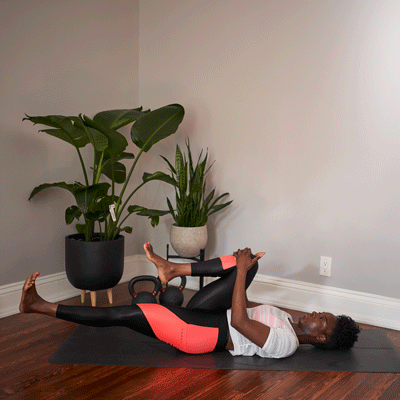
- Lie on your back with your knees bent and your feet flat on the floor (A).
- Using both hands, pull up one knee and press it to your chest (B).
- Tighten your abdominals and press your spine to the floor.
- Hold for 5 seconds.
- Return to the starting position and repeat with the opposite leg (C).
- Return to the starting position and then repeat with both legs at the same time (D).
- Repeat each stretch 2 to 3 times — preferably once in the morning and once at night.
2.Bridge exercise
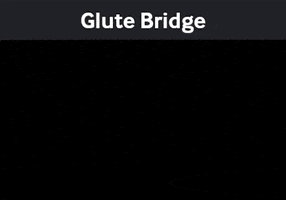
Bridge Exercise works the hamstrings, lower back, abs, in addition to the glutes. With many of the benefits similar to that of a squat, another plus for the glute bridge is that it does not place any pressure on the lower back. This is also a great exercise for people who are unable to squat due to back, hip, or knee pain.
- Lie on your back with your knees bent and your feet flat on the floor (A).
- Keeping your shoulders and head relaxed on the floor, tighten your abdominal and gluteal muscles.
- Raise your hips to form a straight line from your knees to your shoulders (B).
- Hold the position long enough to complete three deep breaths.
- Return to the starting position and repeat.
- Start with five repetitions each day and gradually work up to 30.
3.Cat/Cow stretch
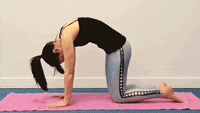
- Increases the flexibility of the neck, shoulders and spine.
- Stretches the muscles of the hips, back, abdomen and chest.
- Strengthens your spine.
- Activates the tailbone
- Releases tension of the neck and upper back.
Procedure
- Position yourself on your hands and knees
- Slowly arch your back, as if you’re pulling your abdomen up toward the ceiling
- Slowly let your back and abdomen sag toward the floor
- Return to the starting position
- Repeat 3 to 5 times twice a day.
4.Lower Back Rotational Stretch
To perform the lower back rotational stretch:
- Lie back on the floor with bent knees and feet flat on the ground.
- Keeping the shoulders firmly on the floor, gently roll both bent knees over to one side.
- Hold the position for 5–10 seconds.
- Return to the starting position.
- Repeat each stretch 2 to 3 times — preferably once in the morning and once at night.
5.Lower back flexibility exercise
- Lie on your back with your knees bent and your feet flat on the floor (A).
- Tighten your abdominal muscles so your stomach pulls away from your waistband (B).
- Hold for five seconds and then relax.
- Flatten your back, pulling your bellybutton toward the floor (C).
- Hold for five seconds and then relax.
- Repeat.
- Start with five repetitions each day and gradually work up to 30.
6.Seated Lower Back Rotational Stretch
- Sit on an armless chair or a stool.
- Cross your right leg over your left leg.
- Bracing your left elbow against the outside of your right knee, twist and stretch to the side (A).
- Hold for 10 seconds. Repeat on the opposite side (B).
- Repeat this stretch 3 to 5 times on each side twice a day.
7. Supermans

- Superman is a floor exercise that involves simultaneously lifting your arms and legs off the ground while keeping your core engaged.
- This move will not only give you abs of steel, but also strengthen your back.
How to perform a Superman:
- Lie face down on the ground and stretch both arms out in front of the body, keeping the legs stretched out and flat on the ground.
- Raise both the hands and feet, aiming to create a gap of about 6 inches between them and the floor.
- Try to pull in the bellybutton, lifting it off the floor to engage the core muscles.
- Keep the head straight and look at the floor to avoid neck injury.
- Stretch the hands and feet outward as far as possible.
- Hold the position for 2 seconds.
- Return to the starting position.
- Repeat 10 times.
8.Lying lateral leg lifts
- Lying lateral leg lifts work the hip abductor muscles that support the pelvis and can help reduce strain on the back.
How to perform lying lateral leg lifts:
- Lie on one side with the legs together.
- Keep the lower leg slightly bent.
- Draw the bellybutton into the spine to engage the core muscles.
- Raise the top leg about 18 inches, keeping it straight and extended.
- Hold the position for 2 seconds.
- Repeat 10 times.
- Turn onto the other side of the body and repeat, lifting the other leg.
- Perform 3 sets on each side.
9.Foam Rolling

How to use foam Roller for lower back pain
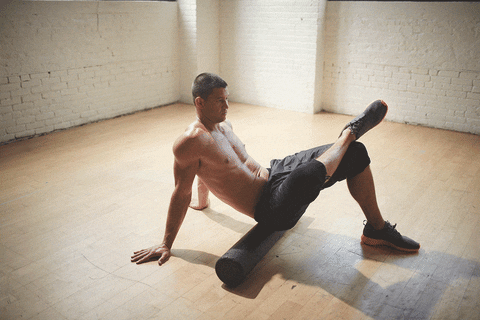
- Place the roller on the floor.
- Sit on the floor in front of the roller and lie back onto it, keeping feet flat on the floor.
- Gently roll forward and back, slowing down or stopping if you feel pain. (A little pressure in tender spots is OK.)
- If possible, sit just in front of the roller and arch your back over the roller as far as is comfortable. Hold for a few seconds.
10.Sphinx/Cobra
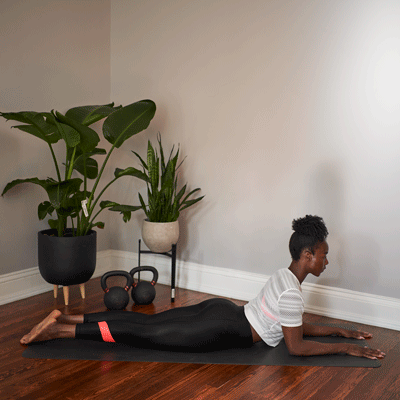
- Lie on your stomach with elbows under shoulders and palms flat on the floor.
- Gently flex glutes and lower back while lifting head and chest, all while pressing your pelvis into the floor.
- Hold your gaze straight, if possible.
- For a deeper stretch, straighten arms while continuing to press your pelvis into the floor.
- Hold this pose for 30 seconds to 1 minute.
- Repeat as needed.
When to get additional help
- Anyone experiencing lower back pain that is severe or does not go away with gentle stretches and exercise should make an appointment with a doctor.
- In general, the best approach to back pain isn’t treatment but prevention. Doing some or all of these stretches regularly should keep your back healthy and flexible and help keep pain from returning.
Performing exercises to work the core muscles can prevent injury, increase stability, and improve flexibility. People with lower back pain should also pay attention to their general posture and how they carry heavy objects to identify movements that may be responsible.
If any of these back exercises make pain worse, it is vital to stop doing them immediately and consult a doctor.
References
Citations
- Long A, et al. (2004). Does it matter which exercise? Spine, 29(23): 2593–2602.
- Hayden JA, et al. (2005). Systematic review: Strategies for using exercise therapy to improve outcomes in chronic low back pain. Annals of Internal Medicine, 142(9): 776–785.


